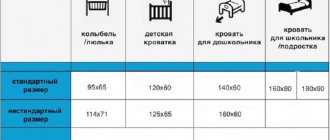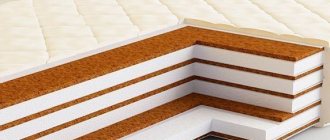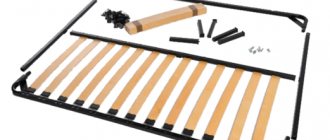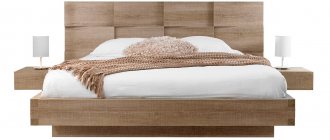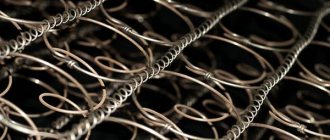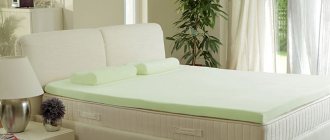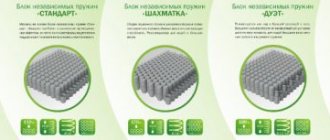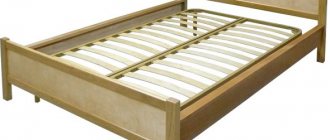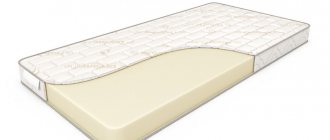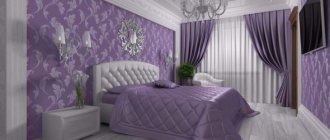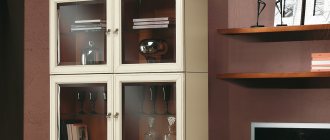We eat right, exercise and try to be outdoors more. But every day, neurologists and psychotherapists are seeing more and more patients: people complain of insomnia and chronic fatigue, constant headaches and apathy. And only a few come to understand over time that the main problem is that no one taught us how to choose a mattress for a bed.
In 2008, the University of Oklahoma conducted an interesting study: volunteers were individually selected suitable mattresses. A survey was conducted 2 weeks later. It showed that 58% of people forgot about the feeling of stiffness in the back, and in 62%, neck pain decreased. Overall, sleep improved in 69% of volunteers. At the same time, no one was interested in the condition of their mattresses before the experiment.
What to look for when choosing?
The best mattress is the one that is selected individually. This is exactly the case when the advice of a friend or neighbor, reviews on a popular forum, or advertising on a billboard will not help. The mattress that will be a salvation for an elderly woman is absolutely not suitable for a young athlete, and a fragile girl is unlikely to appreciate a product that an overweight man was delighted with.
It is the thoughtless choice of mattress that most often leads to disappointment. But everything can be different if you don’t rely on the professionalism of a consultant in the salon, but take full responsibility on yourself: understand the types of mattresses and their fillings, read the selection rules based on weight and height. Well, we will dwell on these and other selection criteria in great detail in the article.
Which mattress to choose: with or without springs?
Structurally, all mattresses are divided into 2 large groups:
- spring ones
, which went on sale many decades ago, and have already earned a reputation for being reliable and durable; - springless
. This category includes both monolithic latex blocks and multilayer products made from natural or synthetic components.
Modern springless mattresses
They began to conquer our bedrooms quite recently - in the second half of the 20th century. At first, their water and air varieties were used only in medical institutions, but for apartments and private houses such products were too difficult to operate. So, an air mattress runs on a noisy compressor. And the water one weighs more than 200 kg, which not every bed can withstand. In addition, even several years after purchase, such products emit a distinct rubber smell.
Only the appearance in stores of sleeping blocks made of latex or polyurethane foam made buyers seriously think about an alternative to spring mattresses. They can be monolithic or composed of several slabs, the properties of which complement each other. The height of springless orthopedic mattresses is 12-14 centimeters, and zones of varying rigidity are formed by the manufacturer using a series of cuts and holes.
Even after several years of use, springless mattresses do not creak and remain completely silent.
Spring mattresses
in turn divided into 2 categories:
- mattresses with spring blocks dependent on each other;
- mattresses with independent blocks
.
Dependent spring blocks - bonnells - attract buyers with a low price. But the design itself is considered flimsy, unreliable and outdated. These are the very mattresses into which you sink, like into a hammock, and you can only dream of a comfortable rest while lying on them.
Independent springs, each of which is packaged in an individual case, have many advantages. They do not creak or produce a wave effect, so they are ideal for double beds, even if the spouses have a large weight difference. When one person turns over in their sleep, the other will not feel any vibration.
Independent springs are much smaller in size than the usual double-cone ones, and in order to fill the mattress with them, you will have to take more of them. This achieves high point elasticity. Moreover, mattresses with independent springs can simultaneously contain blocks of varying degrees of hardness, which is completely impossible for bonnels.
Springless orthopedic mattresses provide dense support, which not everyone will like. But resting on elastic products with independent spring blocks is comfortable for almost everyone.
Types of mattresses
The first characteristic to be guided by is the design. And there are four main types.
Springless
They consist of a cover and some internal filler. It depends on what kind of padding is present whether the “featherbed” will be of high quality, durable and comfortable.
On such a bed you experience slightly different sensations, since there is no usual vibration of the springs. The advantages of these models include:
- noiselessness - due to the absence of metal parts, they do not creak over time, like spring ones;
- ease of transportation - they are lighter than other types, and many can even be rolled, which provides incomparable advantages during transportation;
- reliability - they are durable (provided you purchase high-quality filler) and are recommended in homes where there are children, because they are allowed to jump on.
However, the advantages are negated if low-grade internal material is chosen, so do not skimp on this important parameter.
With dependent springs
They are also called classic or Bonnell. The springs are intertwined and dependent on each other: changing the position of one of them leads to a change in the others. We are not talking about any supporting action.
In addition to the fact that such products do not benefit your back health, they are also endowed with other disadvantages:
- elements rub against each other, and therefore creak;
- the space between the spirals is not filled with anything and dust accumulates there, which negatively affects health;
- couples who sleep together experience certain inconveniences: the heavier partner seems to “fall” into a hole, and the lighter one constantly slides towards him. In addition, when one of the spouses moves, a “wave” passes through, which the other also feels;
- after some time, depressions appear in some places, which is why the sleeping position becomes unnatural and an excessive load is placed on the spine.
However, the low price allows these products to remain on the market. They are often used for rental housing, in guest rooms and in country houses. And this approach is justified, because for little money you get comfort, but with some reservations.
With independent springs
The design is different from the previous one. In it, each spring is in a separate fabric bag and is completely isolated from the rest. This eliminates contact between parts, which means there is no “hammock” effect. The recess appears only directly at the point of pressure, while neighboring elements are not involved.
Proper support of the spine and load distribution are ensured. The body really rests. Such products are free of other disadvantages: they do not creak, do not sag over time, and it is pleasant for two people to sleep on them.
Of course, the price of mattresses with independent spirals is higher than the previous type. It is also determined by such a factor as the number of springs per 1 square meter. m:
- 120–160 are inexpensive models, but their orthopedic properties are weak;
- 250–300 is the standard amount, which is typical for most options, and is sufficient for comfortable sleep;
- 500–1000 – can be recommended for those who have back problems and are overweight.
Water
An exotic variety, rarely found in Russian apartments. Has one or more chambers filled with water. Ideally adapts to the shape of the body and promotes relaxation, and therefore is often called the most comfortable. In addition, such products have automatic heating, and every day you go to bed in a warm place, which promotes even greater relaxation.
Despite its apparent unreliability, it is not easy to damage the stock. But his other flaws are significant:
- heavy weight - it reaches 900 kg, so there are certain difficulties in moving furniture;
- difficulties with installation and connection - adjustment work must be carried out by a qualified specialist, who is not always possible to find;
- additional maintenance - once a year a special preparation should be added to the water, which stops the growth of microorganisms, and once every 2-3 years the liquid will have to be renewed, and for this you will also need a specialist;
- not suitable for everyone - those who are accustomed to hard surfaces will find elastic and soft ones uncomfortable;
- “biting” price.
If you are interested in purchasing one, try to find a place where you can sleep on a waterbed. For example, in a hotel or with friends. This will allow you to assess whether this option is right for you.
What kind of cover should it be?
Mattress covers are made from a variety of materials:
- natural
- cotton or linen; - combined
- cotton with the addition of synthetic threads; - artificial
- polyester, polypropylene.
The best option is fabric made from combined fibers of jacquard weave. It is strong, durable, almost wrinkle-free and can easily withstand repeated washing. Modern anti-allergenic impregnations should not be underestimated. They reliably prevent the proliferation of dust mites, the fruits of whose vital activity cause allergies.
Most buyers prefer removable covers. And completely in vain! Yes, you can always remove it and wash it, but there is no guarantee that the product will not shrink. In addition, putting the cover back on yourself without tearing it is often an almost impossible task.
Another thing is the non-removable cover. It is evenly stretched over the entire surface of the mattress, giving strength and extending the service life of the entire structure. And the issue of combating pollution is easily solved by dry cleaning at home.
Poor quality mattress stitching should alert you. If already in the store you see broken threads and missed stitches, this indicates that the product will not last long.
Choosing a filler
The space between the upholstery and the springs is occupied by filler. Its task is to redistribute the weight load, add additional rigidity or, conversely, add a little softness to an overly rigid product. Both natural and synthetic materials can act as filler. Each of them has its own advantages and disadvantages.
Natural fillers
Coconut coir
. It is made from coconut fibers and is considered an ideal filler for hard mattresses. It does not rot, does not absorb water and odors, thanks to lignin, a natural polymer, it is elastic and has pronounced orthopedic properties. It never gets hot on a coconut coir mattress, dust mites do not grow in it and fungus does not develop.
Only the manufacturer can ruin a coconut coir mattress. Ideally, the fiber should be impregnated with natural latex, and then formed into a monolithic block. It does not crumble and serves for years without losing its properties. But you can also save money: make the slab using the pressing method. It will turn out to be fragile and short-lived, but it will cost the buyer almost 2 times less.
Sisal or cactus coir
. The name is not entirely true, since the source of fiber is agave, a plant that only superficially resembles a cactus. Sisal is much softer than coconut coir, but at the same time it is a very durable material that can cope with serious operating loads.
Unfortunately, such a filler is still exotic today. Although in terms of its elasticity and strength it can easily compete with high-tech synthetic materials. Sisal is highly breathable and does not absorb water. It also absorbs sound very well. Therefore, by turning over in your sleep, you are guaranteed not to wake up people sleeping in the same room.
Seaweed
. This filler is a natural antibiotic. It literally fills the air around it with freshness and iodine vapor, making breathing easier. That is why naturopathic doctors recommend a mattress filled with algae for patients with shortness of breath, bronchial asthma, and reduced immunity.
Wool
. The winter side of double-sided mattresses is often lined with wool, ideally horsehair. It is very elastic and retains the heat of the human body for a long time. Unfortunately, such mattresses are contraindicated for allergy sufferers.
Natural latex
. Natural filler from the milky sap of Hevea or rubber tree. Environmentally friendly, extremely durable, with a dense but breathable structure reminiscent of a honeycomb. Manufacturers have learned to give latex mattresses different degrees of hardness, including creating softer or, conversely, harder zones in one product. The only drawback of natural latex is its high price. Otherwise, this filler is considered ideal.
Synthetic fillers
Polyurethane foam
. Improved foam rubber with increased rigidity. One of the most affordable fillers, which, nevertheless, is used even by famous manufacturers. Hypoallergenic, breathable and very elastic. Polyurethane foam filling is used to produce soft mattresses.
Embossed latex polyurethane foam
. The same foam rubber, but impregnated with natural latex. Thanks to this treatment, the material acquires greater elasticity and durability. And its relief surface gives the products a pronounced massage effect.
Viscoelastic foam or Eco-foam
. Another modification of polyurethane foam. The material cells have different sizes and different wall thicknesses. Therefore, Eco-foam is able to withstand much greater loads than its predecessors. The price of the filler is low, but the most attractive property of the material is the ability to completely restore its original shape after compression.
Artificial latex
. It costs tens of times less than natural rubber, but it does not exactly follow the shape of the human body, although it still resembles its natural analogue in its properties. Moderately soft, deformation-resistant, breathable and hypoallergenic. This filler is a godsend for people with large body weight: even with a pressure of 150 kg per bed, the filler confidently retains all its properties.
Holofiber
. A synthetic analogue of natural wool. Used for the winter side of double-sided mattresses. Elastic, breathable, retains heat well, but does not tolerate folding and bending.
Memorylatex and memoryform
. Viscous, resilient memory foam material. Reacts to the warmth of the human body and is gently affected by it. This filler does not exert back pressure, so it is recommended for people with circulatory problems and sore joints. Sleeping on a memorylatex mattress is very comfortable: a complete feeling of weightlessness is created and maximum relaxation is achieved. After removing the load, such a mattress slowly returns to its original shape. The main advantage is record durability.
Technogel
. An analogue of memorylatex, but if the latter is pressed only downwards, the technogel literally envelops the body and reacts sensitively to any movements. Mattresses with such filling have a pronounced anti-decubitus effect, but are expensive.
Combined fillers
Struttofiber
. Medium hard filler. Its structure is similar to holofiber, but has inclusions of natural fibers - flax, cotton, wool or eucalyptus. It is well ventilated, lasts a long time, but does not tolerate bending and twisting well.
Biococonut
. Consists of natural coconut coir and synthetic fibers. It is used as a more affordable analogue of coconut board, although it is inferior to it in both rigidity and elasticity. The material is resistant to heavy loads and lasts a long time, but sleeping on such mattresses in the heat will not be as comfortable as on natural ones.
Natural fillers are most often too hard. Synthetic ones do not always provide a good supporting effect. Therefore, the future belongs to combined fillers. In the meantime, the most worthy option: a mattress with alternating layers of natural latex and coconut coir.
Mattress filler
The composition of the mattress largely determines its durability, medical indications or contraindications, orthopedic properties, and most importantly, pricing policy. Fillers can be artificial or natural.
Fillers can be artificial or natural.
Coconut coir
A common filler made from coconut fibers. Mattresses that have a springless design and are filled with coir are very hard. In most cases, they are purchased only on the recommendations of the attending physician or by lovers of “hard recreation”. The advantages of such a sleeping place include naturalness and environmental friendliness. The material conducts air well, is not susceptible to fungi, has a bacterial effect, is strong and durable. Not prone to rotting and deformation. To give softness and elasticity, coconut coir is supplemented with latex.
The material conducts air well, is not susceptible to fungi, has a bacterial effect, is strong and durable.
Note! Sometimes compressed coir is used to fill the mattress. This type of filler is considered to be of poor quality and short-lived.
Polyurethane foam
This is ordinary foam rubber, endowed with increased rigidity. Products made from it are in demand; the composition is often used to make mattresses from a variety of famous manufacturers. The product is considered durable, medically useful and very attractively priced.
The product is considered durable, medically useful and very attractively priced.
Wool
Suitable for lovers of warmth. Manufacturers combine the layers of the mattress so that only one side is wool. In this case, the product is called multi-seasonal. In winter it lies with its fur facing up, and in summer it lies downwards. Horse hair is considered the best filler option. This material makes the surface elastic, retains heat and at the same time has good orthopedic properties.
Horse hair is considered the best filler option.
Seaweed
This composition has only begun to gain popularity in the last few years. Algae improves immunity and makes breathing easier. This mattress is healthy, characterized by excellent antibacterial properties, hygienic and durable.
Algae improves immunity and makes breathing easier.
Combined fillers
Characteristic in the production of multilayer mattresses. To acquire certain properties and achieve the desired effect, layers with different fillers are combined, creating an individual option for the buyer. The most popular is the combination of latex and coconut coir.
The most popular is the combination of latex and coconut coir.
Memory material
They appeared on the market relatively recently and almost immediately gained popularity. They have a memory effect and remember the shape of the sleeper’s body, and do not exert reciprocal pressure, thanks to the composition of a kind of foam. When a person wakes up and stands up, the surface slowly straightens and takes on its original appearance. They are durable, such products have nothing to break, crack, or wear out. If the optimal temperature and humidity are maintained, it will last for more than one generation. Manufacturers offer such mattresses with varying degrees of hardness: from the smallest to very hard models. Cost is the only significant drawback of this type. Almost all products are made from natural materials, environmentally friendly, and therefore are available only to buyers with a “tight” wallet.
They are durable, such products have nothing to break, crack, or wear out.
Latex
The most famous and sought-after filler for modern mattresses. It is offered on the market in synthetic and natural versions. Natural latex is made from the sap of the rubber tree, through careful heat treatment and further vulcanization. The result is an elastic, dense, “breathable” structure reminiscent of a honeycomb. Such products are durable, harmless and environmentally friendly. They envelop the structure of the body, and the design allows you to create different stiffness in certain areas of the mattress, and thereby increase the orthopedic effect. Latex is an ideal filling for a sleeping place and its only drawback is its high price. Products with one solid perforation are much cheaper than combined blocks of different hardness, but even then they cannot be called budget.
Latex is an ideal filling for a sleeping place and its only drawback is its high price.
Struttofiber
The material has good elasticity, moisture resistance, does not burn, does not deform, is well ventilated and does not cause allergic reactions. The structure of the filler is not ordinary - the fibers in this case are arranged vertically, thereby ensuring good air circulation. It has a high service life, can be manufactured to any hardness, and can be combined with other fillers. However, in terms of price, it is close to expensive latex models.
It has a high service life, can be manufactured to any hardness, and can be combined with other fillers.
Choosing the height and size of the mattress
The mattress must exactly match the size of the bed: not hang over it, but also not leave a margin around the edges. Minimum recommended bed size: your height plus 20 centimeters. At the same time, the width of a single bed is from 80 centimeters; double bed – from 160 centimeters. There is also an intermediate, one-and-a-half-sleeper version: its width is 120 centimeters.
The height of the mattress is equally important. A person’s well-being in the morning directly depends on it. So, mattress heights:
- up to 10 cm
are intended for children; - 12-15 cm
are suitable for schoolchildren; - 15-25 cm
– universal models for adults; - 25-40 cm
- expensive mattresses that can provide maximum orthopedic effect.
The beneficial effect of thin mattresses on the musculoskeletal system is nothing more than an advertising gimmick. Such products are intended for temporary use, when it is necessary to reduce the inconvenience of a sleeping place on a trip, at the dacha, or in a rented apartment.
How is an orthopedic mattress different from a regular one?
An orthopedic mattress is primarily intended for the treatment of injuries to the musculoskeletal system caused by various diseases and injuries. It is also indicated for the prevention of scoliosis in childhood.
It is unlikely that older people will sleep comfortably on such a mattress. There is no need to purchase an orthopedic mattress for a double bed unless both spouses suffer from severe back pain. This mattress will not appeal to those who are used to resting on a soft mattress and do not want to change their habits. But if you read real reviews of orthopedic mattresses from people who have spinal diseases, you will see how useful and necessary an invention this is.
Choosing hardness
There is an opinion that you need to sleep on a hard surface. This is a dangerous misconception, since you should select the firmness of the mattress, first of all, based on your own weight and age.
With body weight:
- up to 60 kg,
a soft mattress or a product of medium hardness is suitable; - from 60 to 90 kg,
the choice should be made based on age and personal preferences; - over 90 kg,
you need a hard mattress with a high-quality spring block. It is very important to pay attention to the weight limit - it is different for each model.
Until recently, spouses with a large difference in weight had to purchase 2 single mattresses. Today this is no longer necessary: you can now buy a double mattress, one side of which is firmer than the other.
For children under 16 years of age, it is better to purchase specialized children's mattresses. You can switch to universal models closer to adulthood. For other age categories, the recommendations are as follows:
- Until the age of 25,
the body is still growing, and the correct position during sleep actively affects the formation of the spine. Therefore, young people are recommended to use exclusively hard mattresses; in extreme cases, products of medium hardness; - from 25 to 45 years
– the time for mattresses of medium hardness, if, of course, we are talking about an average person without obvious deviations in the musculoskeletal system; - Over 45 years old
is the age when it’s time to pamper yourself. Blood circulation is no longer as intense as in youth, and therefore hard mattresses cause severe discomfort - the limbs become numb and it is not possible to get enough sleep. If there are no special recommendations from an orthopedist, you can safely look at soft mattresses.
General recommendations: the heavier a person is, and the younger he is, the harder the mattress should be. A universal option is a medium-hard model. A mattress that is too soft will turn your sleeping area into a hammock, and a mattress that is too hard will interfere with blood circulation.
Why is mattress firmness important?
Mattress hardness
– one of the most important criteria for choosing a suitable model. This indicator determines how correctly the spine will be positioned during sleep, avoiding unnatural bends. The required degree of rigidity is selected depending on the weight and height of the user, as well as age and health.
For example, soft and moderately soft mattresses are chosen for children from 8 to 15 years old and the elderly. Softness is provided by various layers: latex, holofiber, orthopedic foam and other materials. A person weighing less than 80 kg is recommended to use a medium-soft mattress. The required rigidity is achieved by combining fillers of different softness. For example, coconut coir or sisal is used as a rigid base, and a soft layer of polyurethane provides comfort. Healthy people of average build and height weighing from 80 to 110 kilograms need medium-hard models, and those with a body weight of more than 120 kg and problems with the spine need medium-hard or hard ones. In such models, coir, sisal and other dense and rigid materials are used.
The table shows examples of the relationship between height, weight and mattress hardness.
| Height Weight | up to 50 | 50-60 | 60-70 | 70-80 | 80-90 | 90-100 | 100-110 | 110-120 | more than 120kg |
| up to 150 | **** | **** | ***** | ***** | ***** | ***** | ***** | ***** | ***** |
| 150-155 | **** | **** | **** | **** | ***** | ***** | ***** | ***** | ***** |
| 155-160 | *** | **** | **** | **** | **** | ***** | ***** | ***** | ***** |
| 160-165 | *** | *** | *** | **** | **** | **** | ***** | ***** | ***** |
| 165-170 | ** | *** | *** | *** | **** | **** | **** | ***** | ***** |
| 170-175 | ** | ** | *** | *** | *** | **** | **** | **** | ***** |
| 175-180 | * | ** | ** | *** | *** | *** | **** | **** | **** |
| 180-185 | * | * | ** | *** | *** | *** | *** | **** | **** |
| 185-190 | * | * | * | *** | *** | *** | *** | *** | **** |
| 190-195 | * | * | * | ** | *** | *** | *** | *** | *** |
| 195-200 | * | * | * | * | ** | *** | *** | *** | *** |
| ˃ 200 | * | * | * | * | * | ** | *** | *** | *** |
| * – soft, ** – medium-soft, *** – medium, **** – medium-hard, ***** – hard | |||||||||
A special category includes mattresses with zones of different hardness: longitudinal or transverse. They are needed in two cases: firstly, if two people of different builds sleep on the mattress. In this case, a heavier person needs a zone of increased rigidity, and a lighter person needs a soft part of the mattress. The second case is transverse zoning, which allows you to distribute the load differently, for example, a reinforced middle zone and softer areas for the head, shoulders and legs. There can be from 3 transverse zones for inexpensive mattresses, and up to 5-7 or even 9 for more expensive models. The more zones, the more comfortable the rest and the better the orthopedic properties of the mattress.
Double-sided and single-sided mattresses
Single-sided mattresses
- a less common option, but more affordable. Such products have only one side intended for sleeping, the second is sealed with the most wear-resistant material. The main advantage of a one-sided mattress is that there is no need to turn it over. But this is also its disadvantage: it will begin to sag much faster than a double-sided model of similar quality.
And yet it is impossible to say that one-sided mattresses are definitely worse. Among them there are premium products, up to 40 cm high, that meet the highest requirements for comfort.
For double-sided mattresses
Both sides are suitable for sleeping. Moreover, this is not necessarily a “winter-summer” effect. You can choose a mattress with different hardness sides, which is especially important for people suffering from back pain. Then, during exacerbations, you need to turn the product with the harder side, and when the spine is not bothered, you need to turn it with the softer side. In any case, periodic rotation of the mattress actively prevents subsidence and extends the service life of the product.
Which mattress to choose for a bad back?
If you have any back problems, you should definitely try a mattress with latex filling. Its inherent memory effect will help relieve excess muscle tension, and the mattress itself can easily adapt to the individual characteristics of your figure. Of course, it will not get rid of osteochondrosis and will not cure a herniated disc, but in general, a good mattress is quite capable of slowing down the development of pathology.
There are a few more tips worth remembering:
- for lower back pain
, a hard mattress is strictly contraindicated, choose from soft models; - for protrusions in the upper spine
, on the contrary, a hard mattress is needed; - for problems in the thoracic region
- a medium-hard mattress.
Note! A hard mattress creates pressure on certain areas of the body, which can impair blood circulation and increase spinal curvature. Therefore, you can purchase mattresses with increased hardness only after the approval and recommendation of an osteopath.
Criteria for choosing a mattress for a bed
To choose the right mattress, you need to take into account parameters such as hardness, filler characteristics and dimensions.
When choosing a product, you should decide on the following criteria:
- The degree of rigidity is selected to suit individual needs. Manufacturers offer mattresses with different hardness: standard, soft or reinforced.
- It is important to measure the internal dimensions of the bed. It is better if the mattress is a little smaller, then it will easily form the basis. The length of the mattress should be at least 20 cm greater than your height.
- Mattress fillers. There are spring and springless options.
- Safety, hypoallergenicity and hygiene are important for health. Some fillers can cause allergies, and certain synthetic materials release toxic components.
- Weight is an important criterion. Overweight people should choose stiffer designs, while thin people should choose soft ones.
When deciding which mattress to choose, you should listen to the opinion of doctors. Elderly people are not recommended to sleep on too hard a base, as this can cause poor circulation and pain in the spine. If you have lower back pain, it is better to choose softer options, and if you have problems in the upper back, then you should opt for hard products. Children's mattresses must be durable, as children will definitely play and jump on the bed.
It is better to choose a mattress for a double bed of medium hardness with independent springs.
Natural materials are durable and environmentally friendly, but can be dangerous for allergy sufferers. Therefore, in this case, it is worth choosing products made from synthetic materials.
Particular attention should be paid when choosing a mattress for a child. A good option is a mattress with separate springs. It is better not to purchase one with a dependent spring block; they do not have the necessary orthopedic properties, which affects the child’s spine.
How to choose an orthopedic mattress?
The main advice of an orthopedist: always test the mattress before buying. Moreover, it is not enough to just lie down for a minute: you need, firstly, to take your usual sleeping position, and secondly, lie down for at least 5-10 minutes. Only after this will it become clear whether the product is convenient or not.
The right mattress will demonstrate 2 effects:
- orthopedic
: ability to support a person's weight. In this case, the spine of a vacationer in a position on his side will be located straight; - anatomical
: the ability to follow the curves of the body.
An anatomical mattress is made by high-quality fillers, an orthopedic mattress is made by springs or base blocks. In models with independent spring blocks, the following levels of orthopedic effect are also distinguished:
- good (S-500)
: 220-300 springs per square meter or 500 springs per bed, as indicated by the abbreviation. Diameter of each spring: 5-6 centimeters; - excellent (S-1000)
: 500 springs per square meter with a diameter of 4 centimeters; - maximum possible (S-1,000)
: 1,000 springs per square meter, each with a diameter of 2 centimeters.
If after 10 minutes of testing you clearly feel more relaxed and rested, this indicates that you have a product with the right stiffness.
Which company is better to choose?
Buying a mattress is not a time when experimentation is appropriate. Leading manufacturers have been testing the effectiveness of structures for years, checking the thickness and composition of the filler layers, reducing and increasing the diameter of the springs, selecting upholstery fabrics and developing stitch patterns.
Time-tested brands:
- “Afalina”
– high-quality mattresses for newborns and preschoolers, made of high-quality hypoallergenic materials; - “Askona”
is the largest domestic manufacturer, whose factories produce not only products of the same brand, but also IKEA and Serta mattresses; - "Ormatek"
. 3.5 million Russians sleep on these mattresses. The advantage of the company is a huge range, which includes mattresses of all types and different hardness; - "DreamLine
" A St. Petersburg company that has focused on affordable prices. At the same time, the brand’s products are distinguished by stable quality and long service life.
Checking the quality of a spring mattress is simple: you need to compress it all the way. The thickness of a good mattress will remain at least 15 centimeters. This suggests that the manufacturer did not save on the number of coils of the spring, and it is they that form the main height of the product, and not many layers of filler.
Approximate prices for mattresses
The cost of a mattress directly depends on its type and type of filling. Of course, buyers will have to pay extra for brand awareness and delivery if the product is imported. But the amount from which prices start can be guessed with high probability even before visiting the salon.
The most inexpensive mattress is a bonnell spring mattress. It will cost the buyer 5,000 - 10,000 rubles. Spring, but with independent blocks:
- 10,000 – 25,000 rubles for S-500 mattresses;
- 20,000 – 35,000 rubles for S-1,000 mattresses;
- 70,000 – 100,000 rubles for S-2,000 mattresses.
Among springless models, the most affordable ones are made of artificial latex. Their price starts at 5,000 rubles. High-quality coconut mattresses cannot cost less than 15,000 rubles, and a block of natural latex – 20,000 rubles.
Sometimes, in an attempt to reduce the cost of a product, manufacturers resort to an obvious trick - thinning out the spring rows. You can check compliance with the standards by placing the mattress on its edge. Give in, they are trying to deceive you!
How often should you change your mattress?
The biggest mistake is to judge the condition of a mattress by its appearance. With careful use, it can look like new for decades, but at the same time its filling ages, and the structure itself gradually loses its ability to provide reliable support to the spine.
Therefore, it is better to focus on the service life specified by the manufacturer. On average it is:
- for mattresses based on a Bonnel spring block – 5 years;
- for mattresses with independent springs – 8-15 years;
- for springless mattresses – 7-12 years;
- for springless latex mattresses - about 20 years.
The actual service life may differ from the recommended one more or less. It is influenced by the weight of the sleepers, frequency of use, and general degree of wear.
How do you know when it's time to replace your mattress?
There is no point in waiting until you can feel the springs on the mattress until it begins to creak or sag. In this case, you have delayed the purchase for at least several years. Orthopedists name 3 earlier signs that make it clear in time that it is time to replace the mattress with a new one:
- 1. In the morning, a dent forms on the bed.
- 2. Lately you have been constantly feeling overwhelmed, although your daily workload has not increased.
- 3. Back pain has become a constant companion. Of course, it may have other reasons, but if the x-ray does not reveal serious violations, it’s all about him - a mattress that has become unusable.
And the longer you delay making a purchase, the faster your health will deteriorate. Therefore, no matter how expensive high-quality mattresses are, it’s worth remembering one thing: you can save on anything, but not on your health!
Rules for choosing a mattress size
Before you go to the store, you should measure the dimensions of the bed. If you are buying a new mattress to replace an old one, then measurements can be taken using the old mattress.
If the dimensions differ slightly from the standard, then an error of up to 1 cm does not matter. But if the difference is greater, then the product must be purchased on an individual order.
The following recommendations will help you choose the right size:
- It is better to purchase a bed and mattress from the same manufacturer.
- The mattress can be ordered according to your individual sizes.
